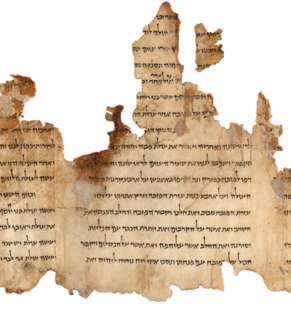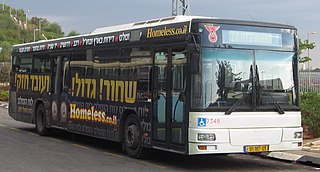
Gush Dan is a conurbation in Israel, located along the country's Mediterranean coastline. It includes areas from both the Tel Aviv and the Central Districts, or sometimes the whole Metropolitan Area of Tel Aviv, which includes a small part of the Southern District as well. The Gush Dan bloc is the largest conurbation and metropolitan area in Israel, with the metropolitan area having an estimated population of 3,954,570 residents, 95% of whom are Israeli Jews. Despite making up less than 8% of Israel's total land area, it houses about 45% of the country's total population.

Ramat Aviv Alef or Ramat Aviv HaYeruka, and originally plainly Ramat Aviv, is a neighborhood in northwest Tel Aviv, Israel.

Tel Aviv central bus station, also known as the new central bus station, is the main bus station of Tel Aviv, Israel. Located in the south of the city, it was opened on August 17, 1993. It is the 2nd largest bus station in the world. The station in Tel Aviv covers 230,000 m2 and a total area of 44,000 m2.

The Herzliya Hebrew Gymnasium, originally known as HaGymnasia HaIvrit is a historic high school in Tel Aviv, Israel.

Kerem HaTeimanim is a neighborhood in the center of Tel Aviv, Israel. The neighborhood is adjacent to the Carmel Market. The name means Vineyard of the Yemenites, and the area is also known as the Yemenites Quarter.

The Haifa Municipal Stadium, more commonly known as Kiryat Eliezer, was a multi-use stadium in the Kiryat Eliezer neighborhood of Haifa, Israel. It was mostly used for football matches and as the home stadium of Maccabi Haifa and Hapoel Haifa. It was replaced by the new Sammy Ofer Stadium at the southern entrance to the city in 2014.
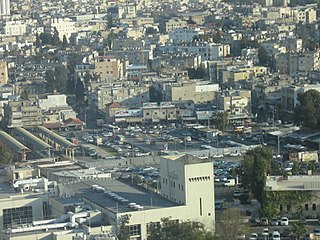
Neve Sha'anan is a neighborhood in Tel Aviv, Israel, founded in 1923.

Neve Tzedek is a neighborhood located in southwestern Tel Aviv, Israel. It was the first Jewish neighborhood to be built outside the old city of the ancient port of Jaffa. Originally a Mizrahi Jewish and Yemenite Jewish neighbourhood, for years, the neighborhood prospered as Tel Aviv, the first modern Hebrew city, grew up around it. Years of neglect and disrepair followed, but since the early 1980s, Neve Tzedek has become one of Tel Aviv's latest fashionable and expensive districts, with a village-like atmosphere. Literally, Neve Tzedek means Abode of Justice, but it is also one of the names for God.
This list of the neighborhoods of Tel Aviv, is arranged geographically from north to south, then from west to east.
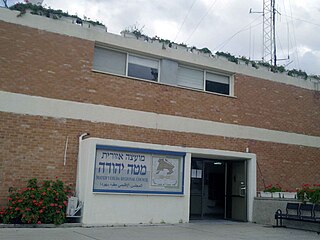
Mateh Yehuda Regional Council is a regional council in the Jerusalem District of Israel. In 2008 it was home to 36,200 people.

Hatikva Quarter is a working class neighbourhood in southeastern Tel Aviv, Israel.

HaKirya, or The Kirya, is an area in central Tel Aviv, consisting of the Camp Rabin military base north of Kaplan Street, and a civilian area south of it.

Yad Eliyahu is a neighborhood in east Tel Aviv, Israel.
Yehuda Hamaccabi is a neighborhood in the north-central part of Tel Aviv. It is named after Judas Maccabeus, one of the great warriors in Jewish history, who led the Maccabean Revolt against the Seleucid Empire.

Hadar Yosef is a residential neighborhood of Tel Aviv, Israel, in the northeastern part of the city. The neighborhood is located to the north of the Yarkon River and near the National Sport Center – Tel Aviv.

Ramat HaHayal is a northeastern neighborhood of Tel Aviv, Israel. Some high tech firms have research and development offices in Ramat HaHayal.
Giv'at Aliyah is a residential neighborhood of Tel Aviv-Jaffa, Israel. It is located in the southern part of Jaffa.
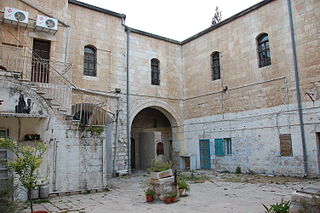
Courtyard neighborhoods are Jewish neighborhoods built in Jerusalem and Tel Aviv in the late 19th and early 20th centuries. The inward-facing and defensible traditional urban housing of the Near East, ordinarily occupied by an extended family, was adapted in these cases to serve a close-knit but genealogically unrelated community.
The following is a timeline of the history of the city of Tel Aviv, Israel.
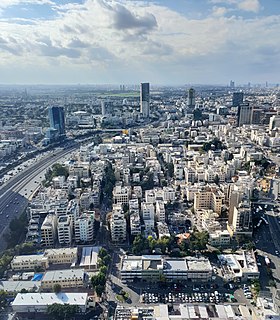
Montefiore is a neighborhood in the center of Tel Aviv, Israel.
